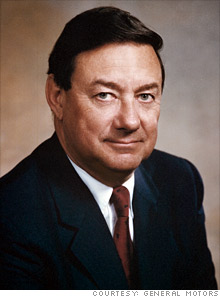Search News
FORTUNE -- Former Procter & Gamble chairman John Smale, who died over the weekend at 84, will forever be remembered as the man who saved General Motors for a time -- and then unwittingly sowed the seeds for its final decline.
Along the way, Smale was responsible for one of the biggest upheavals in corporate governance of the 20th century: boards of directors rising up against underperforming CEOs.
 |
| John Smale |
When GM's board, led by Smale, ousted CEO Robert Stempel, president Lloyd Reuss, and others in 1992 as GM (GM, Fortune 500) faced bankruptcy, it ignited a boardroom revolution. Soon there after, IBM's (IBM, Fortune 500) board would force the retirement of CEO John Akers, and American Express (AXP, Fortune 500) would say good-bye to CEO James Robinson.
Smale was retired from P&G (PG, Fortune 500) and had been serving on the GM board since 1982 when his fellow directors asked him to lead a fact-finding mission into GM's financial condition. Smale was suspicious of the data that Stempel and Reuss were giving the board about quality and customer satisfaction. It was cheerier than the facts warranted. The low numbers were symptoms of a larger problem. GM was already suffering from overcapacity, overlapping brands, and over-the-top wages and benefits -- the same ills that would sink the company 15 years later.
After a few weeks of snooping around, Smale reported back to the board in March 1992. He had found that GM was inefficient and slow to market, and a sweeping reorganization was needed. Change came slowly at first. Stempel reacted slowly and stubbornly to the news. He ignored the board's suggestion that he move aside two executives and couldn't bring himself to dismiss Reuss as the board recommended. After a board vote in April, Stempel was allowed to remain as chairman and CEO, but in a clear sign of displeasure, the directors named Smale as chairman of the executive committee.
The new setup didn't work as Stempel, once again, moved slowly to make necessary changes. By October he was out. Smale became non-executive chairman of the board, and Jack Smith, a GM lifer but a much more flexible and reform-minded executive, was installed as CEO.
GM was ready for new ideas, and Smale had plenty of them. Reaching back to his toothpaste-and-detergent days, he became an enthusiastic backer of brand management. The goal was to develop a distinctive identity for each of GM's more than 70 nameplates. To inject some new ideas into the company, brand managers were created, some of whom came from the packaged goods world. GM publicized their hires as evidence of a new way of doing things. Insiders disparaged them for their backgrounds in the marketing of pencils and snack foods.
Some of the brand-management ideas made sense, such as promoting a car during its entire life on the market, instead of just at launch. But GM never embraced the idea. Customers didn't want to buy a LeMans -- they argued -- they wanted to buy a Pontiac. Pontiac was the brand, not LeMans, so it made no sense to position models as such.
Another idea from the new regime was "needs segmentation marketing." Instead of looking at cars along a continuum from small to large, cheap to expensive, GM would try to design specific models for specific customer segments, based on age, income and lifestyle. Smale was said to be "pretty excited" about the concept.
Unfortunately, the needs segmentation marketing destroyed any continuity of design within the brands, because each model was conceived in a vacuum. It led to cars like the Pontiac Aztek crossover, which seemed to have dropped in from outer space and bore little relation to anything else in the Pontiac lineup. Aztek was festooned with features like a tent-and-picnic-table adaptable tailgate, but the whole was much less than the sum of its parts.
To champion all these new ideas within the company, Smale pushed for an outside marketing expert and became the leading backer of Ron Zarrella, who had been selling contact lenses for Bausch and Lomb. Smart and ambitious, Zarrella had some good ideas and liked to speak his mind. He aroused the ire of dealers by speculating about the benefits of selling cars on the Internet. He also ruffled loyalists when he questioned how the popular but old-fashioned DeVille would fit with New Age Caddies like the CTS.
Zarrella had the misfortune to be associated with some memorable flops, like the GMC XUV, an ungainly sport-utility with a sliding rear roof in place of a tailgate, perfect for hauling large potted plants but unsuited for much else. He also defended the homely Aztek, attributing its poor sales to high prices, small wheels, and two-tone plastic lower body cladding rather than a fundamental flaw in its design The Aztek was finally discontinued in 2005; Zarrella had returned to Bausch and Lomb long before, in 2001.
Smale turned the chairmanship of the board to Jack Smith in 1995 and retired from the board in 2002. GM would soon begin its slide into bankruptcy. The SUV boom and overall economic prosperity of the 90s made it profitable for a while. But Smale (and Smith) were never able to solve GM's underlying problems of too many brands, employees, and dealers, coupled with too much arrogance and too little accountability. Getting Stempel and Co. out was a good first lap, and Smale's board certainly displayed more courage than old GM's last board under George Fisher. Unfortunately, Smale stopped too soon, and his revolution ran out of gas. ![]()